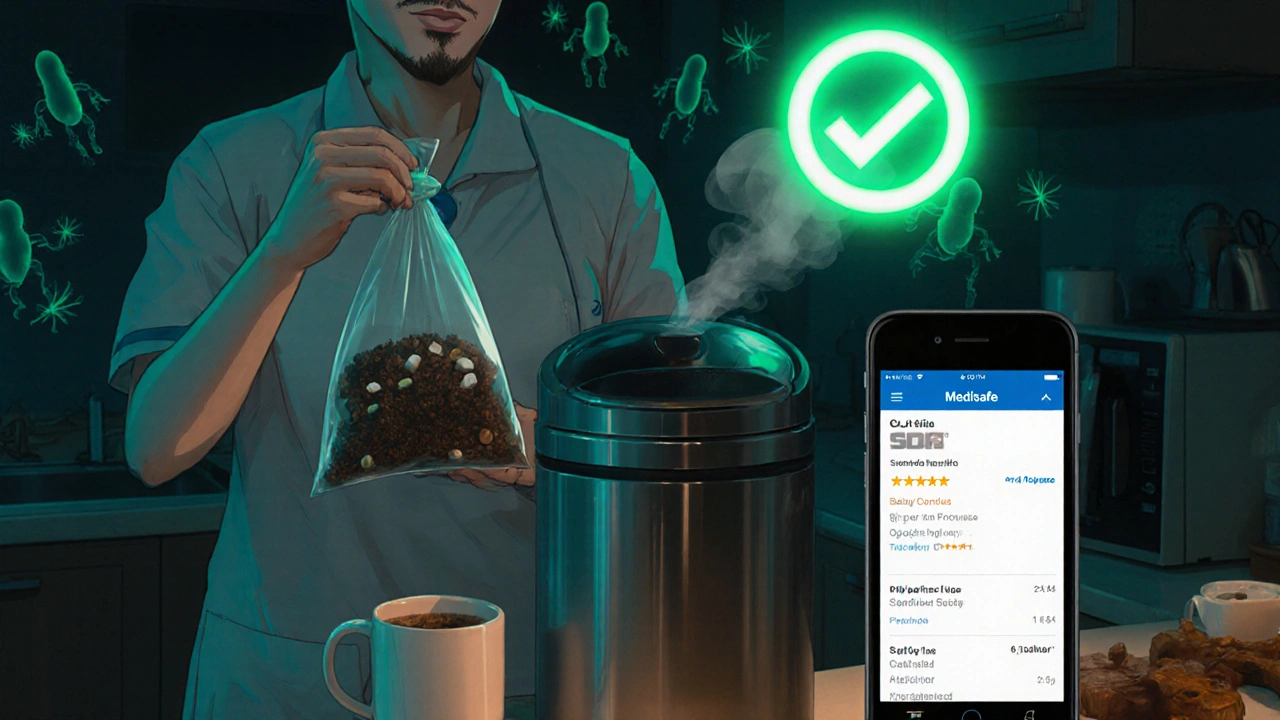 Nov, 14 2025
Nov, 14 2025
Most people think taking antibiotics means popping pills until you feel better. But that’s not enough. In fact, it’s dangerous. If you stop early-no matter how good you feel-you could be helping create superbugs that don’t respond to any medicine. And if you keep leftover pills in the medicine cabinet, you’re risking someone else taking them, or worse, flushing them down the toilet and poisoning water supplies. This isn’t just a hospital problem. Antibiotic stewardship at home is one of the most urgent, yet overlooked, public health tasks today.
Why Finishing Your Antibiotic Course Matters More Than You Think
When you start antibiotics, the strongest bacteria die first. That’s why you feel better in a day or two. But the tougher ones? They’re still alive. If you quit early, those survivors multiply. They become resistant. And next time you get sick, the same antibiotic won’t work.
The CDC says stopping antibiotics too early is one of the top three reasons antibiotic resistance spreads in homes. Studies show incomplete courses raise the risk of resistance by 23% to 37%. That’s not a small number. It means nearly one in four people who skip doses could be creating a problem that lasts years.
For seniors-34% of all home antibiotic users-this is even more critical. Many take multiple medications. A pill organizer might have seven slots. One of them is for amoxicillin. But if the alarm doesn’t go off at 2 a.m., or the caregiver forgets, the dose gets skipped. That’s exactly what happened in a 2023 Reddit thread with over 1,200 comments from caregivers. One wrote: “My mom’s on seven meds. I can’t remember which one’s which at 3 a.m. without a system.”
So how do you fix this? Use reminders. Set alarms on your phone for every dose. Use a pill box with built-in alerts. Apps like Medisafe have a 4.7-star rating from over 14,000 users. Or invest in a smart dispenser like Hero, which costs $299 upfront and $25 a month to run. It locks doses until the right time and texts you if one’s missed. These tools aren’t luxuries-they’re lifelines.
Never Save Leftover Antibiotics for Next Time
You had a urinary tract infection last winter. You finished the pills. But there were three left. You put them in the drawer. “Just in case.”
Don’t.
That’s not saving money. That’s playing Russian roulette with your health. Antibiotics are targeted. The one that worked for a UTI won’t help a sinus infection. Taking the wrong one can make things worse. It can hide symptoms. Delay real treatment. And if the bacteria in your body have already been exposed to that drug before? They’re primed to resist it.
According to a CDC survey, 61% of home users keep leftover antibiotics. Only 29% know how to dispose of them properly. That’s a massive gap. And it’s why resistant infections are rising. The FDA and CDC both say: never reuse old antibiotics. Never give them to someone else. Even if their symptoms look the same.
There’s no such thing as “emergency stock.” Antibiotics aren’t like painkillers. You can’t just take a few if you feel under the weather. If you get sick again, call your doctor. Get a new prescription. It’s safer, cheaper in the long run, and protects everyone else.
How to Dispose of Unused Antibiotics (The Right Way)
Flushing them down the toilet? Throwing them in the trash without doing anything else? Those are common-but wrong-habits.
Antibiotic residues have been found in 63% of U.S. waterways near populated areas. That’s not just an environmental issue. It’s a health threat. Bacteria in rivers and lakes are learning to survive these drugs. Those resistant bugs can spread back to humans.
The FDA’s official advice is simple: mix unused pills with something unappetizing-like used coffee grounds, cat litter, or dirt. Put them in a sealed bag or container. Then throw them in the household trash. Don’t crush them. Don’t dissolve them. Just mix and toss.
Some pharmacies offer take-back programs. In the UK, you can drop off old meds at any pharmacy for safe disposal. In the U.S., check with your local pharmacy or use the DEA’s National Prescription Drug Take Back Day (usually in April and October). But if that’s not an option, the coffee grounds trick works. It’s messy. It’s not glamorous. But it’s the safest thing you can do.

What You Should Do When You Start an Antibiotic
Don’t just grab the prescription and go. Have a plan before you even open the bottle.
- Ask your doctor: “What’s this for? How long should I take it? What happens if I miss a dose?”
- Write down the schedule: “Take 1 pill every 8 hours, starting at 8 a.m.”
- Set alarms on your phone for each dose-even if you think you’ll remember.
- Use a pill organizer. Buy one with compartments for morning, afternoon, evening, and night.
- Keep the original bottle. It has the name, dosage, and expiration date.
- Ask: “Do I need to finish all of these? Or can we reduce the prescription?”
Some doctors now prescribe smaller packs-just enough for 5 days instead of 10-if the infection is mild. That’s a good thing. But only if you’re sure you don’t need more. Never guess.
Recognizing When Antibiotics Might Not Be Needed
Not every cough, sore throat, or earache needs antibiotics. Viruses cause most of these. Antibiotics don’t kill viruses. They’re useless-and harmful-when used unnecessarily.
Signs an infection might be viral:
- Clear or white mucus (not green or yellow)
- Symptoms lasting less than 10 days
- Fever that goes down after a couple of days
- No worsening after day 3-5
But here’s the catch: you shouldn’t decide this yourself. Talk to your doctor. Ask: “Is this bacterial? Or could it be viral?” If they say “it’s probably viral,” don’t push for antibiotics. If they say “we’ll wait and see,” follow that plan. Waiting isn’t ignoring-it’s smart stewardship.

What Caregivers Need to Know
If you’re caring for an elderly parent or someone with memory issues, you’re on the front lines of antibiotic stewardship. Here’s what you need to do:
- Keep a written log of every dose given. Note the time and whether it was taken.
- Call the doctor if the person gets worse after 48 hours-or doesn’t improve after 72 hours. That’s called an “antibiotic timeout.” It’s standard in nursing homes. It should be in homes too.
- Watch for side effects: diarrhea, rash, nausea, yeast infections. These can mean the antibiotic isn’t working right-or is harming good bacteria.
- Don’t assume “no fever = better.” Some infections don’t cause fever. Look at energy levels, appetite, and breathing.
Only 31% of family caregivers get formal training on medication management. That’s not enough. Ask your pharmacist for a 10-minute demo. Request a printable dosing chart from your doctor’s office. Use free tools from the CDC’s Be Antibiotics Aware campaign.
What’s Changing in 2025
The CDC is finalizing its first-ever Home Care Antibiotic Stewardship Core Elements, due out late 2025. That’s a big deal. Right now, hospitals have strict rules. Nursing homes have guidelines. But homes? Almost nothing.
Meanwhile, new programs are popping up. Johns Hopkins piloted telehealth check-ins for home antibiotic users. Patients got a video call after 48 hours. Result? 28% fewer unnecessary antibiotic days.
And the FDA’s 2024 National Action Plan aims to cut inappropriate antibiotic use in homes by 15% by 2027. That means more education, better labeling, and possibly new rules for pharmacies.
But none of this matters unless you act now.
What if I miss a dose of my antibiotic?
If you miss a dose, take it as soon as you remember-if it’s within a few hours of the scheduled time. If it’s close to the next dose, skip the missed one and go back to your regular schedule. Never double up. Taking too much can cause side effects like nausea, diarrhea, or even kidney damage. If you miss two doses in a row, call your doctor. Don’t guess.
Can I save antibiotics for my child next time they get sick?
No. Antibiotics are prescribed based on weight, age, infection type, and medical history. What worked for your child last time might be the wrong dose or wrong drug this time. Giving them leftover antibiotics can delay proper treatment, cause allergic reactions, or create resistant bacteria. Always get a new prescription.
Why can’t I just flush antibiotics down the toilet?
Flushing antibiotics pollutes water systems. Studies show antibiotic residues are in 63% of U.S. rivers and streams near cities. These chemicals don’t break down easily. They expose bacteria in the environment to low doses, helping them evolve resistance. That resistance can spread back to humans through food, water, or contact. The safest method is mixing pills with coffee grounds or cat litter and tossing them in the trash.
Do I need to finish the whole course if I feel fine?
Yes. Feeling better doesn’t mean all the bacteria are gone. The strongest ones die first. The tougher ones hang on. If you stop early, those survivors multiply and become resistant. Studies show incomplete courses raise resistance risk by up to 37%. Finishing the full course-even if you feel great-is the only way to make sure the infection is truly gone.
Are there any apps that help manage antibiotic doses?
Yes. Apps like Medisafe, MyTherapy, and Hero (a smart dispenser) help track doses, send alarms, and notify caregivers if a dose is missed. Medisafe has a 4.7-star rating on the Apple App Store from over 14,000 users. These tools are especially helpful for people on multiple medications or for caregivers managing complex schedules.
How do I know if I need antibiotics at all?
You can’t always tell. Viral infections (like colds or flu) don’t need antibiotics. But bacterial infections (like strep throat or UTIs) do. Don’t assume. Ask your doctor: “Is this bacterial? What’s the evidence?” If they say “we’ll wait and see,” trust that. Pushing for antibiotics when they’re not needed only helps resistant bugs grow.
Final Thought: This Isn’t Just About You
Every time you finish your antibiotic course and dispose of leftovers properly, you’re not just protecting yourself. You’re protecting your neighbor. Your child. Your grandparent. The person in the hospital next year who needs antibiotics to survive surgery. Antibiotic resistance doesn’t care where you live. It doesn’t care if you’re rich or poor. It spreads through water, air, and touch. And it grows fastest where people don’t know how to use these drugs right.
You don’t need to be a doctor to make a difference. Just follow the rules: finish the course. Don’t save leftovers. Don’t share. Dispose safely. Ask questions. And help others do the same.